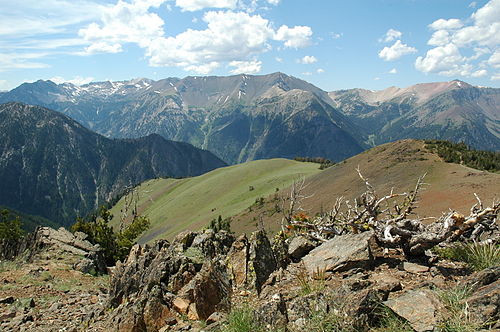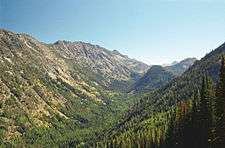Wallowa Mountains
The Wallowa Mountains (/wəˈlaʊwə/) are a mountain range located in the Columbia Plateau of northeastern Oregon in the United States. The range runs approximately 40 miles (64 km) northwest to southeast in southwestern Wallowa County and eastern Union County between the Blue Mountains to the west and the Snake River to the east. The range is sometimes considered to be an eastern spur of the Blue Mountains, and it is known as the "Alps of Oregon".[3][4] Much of the range is designated as the Eagle Cap Wilderness, part of the Wallowa–Whitman National Forest.
| Wallowa Mountains | |
|---|---|
 The Wallowas from Mount Howard. Hurwal Divide is in the front and center, and Sacajawea Peak is behind and to the left. Matterhorn is on the far right. | |
| Highest point | |
| Peak | Sacajawea Peak, Eagle Cap Wilderness, Wallowa County[1] |
| Elevation | 9,838 ft (2,999 m) [2] |
| Coordinates | 45°14′42″N 117°17′33″W [1] |
| Dimensions | |
| Length | 40 mi (64 km) NW–SE |
| Geography | |
| Country | United States |
| State | Oregon |
| Counties[3] | Wallowa Union |
| Range coordinates | 45°12′00″N 117°19′04″W [3] |
Geography
The range is drained by the Wallowa River, which flows from the north side of the mountains, and its tributary the Minam River, which flows through the west side of the range. The Imnaha River flows from the east side of the range.
The highest point in the range is Sacajawea Peak, which is 9,838 feet (2,999 m) above sea level.[5] Sacajawea is the sixth highest mountain in Oregon and the state's highest peak outside of the Cascade Range.[6]
Geology
Many geologists believe that the Wallowa Mountains in northeastern Oregon are a displaced fragment of the Insular Belt.[7] The core of the Wallowas is composed of the Wallowa Batholith surrounded by Columbia River basalt.[8] In addition there are many older terranes between the batholith and basalt flows.[9]
The Wallowa Batholith is formed of granite from a magma upwelling in Late Jurassic and Early Cretaceous time (between 160 million and 120 million years ago).[9] The placement of this rock caused uplift of the surface, which at the time was tropical sea. This is evident from the slate, quartzite, and marble present in the mountains, which come from metamorphism of the sedimentary deposits of oceans during the Triassic.[10] At the center of the Batholith are granodioritic rocks, while the outer limits of the range are tonalitic.[11] The granite batholith is cut by dikes;[12] however, these are uncommon.[11]

Glaciers carved out the valleys during the late Pleistocene, which left a number of moraines.[13] The series of moraines is formed by a series of glacial advances and retreats. Glacial till is also a common feature of the valleys.[14] The melting of the glaciers produced a large quantity of water, which carried sediment to the valley bottoms, leaving delta deposits on top of the former deposits.[15]
Climate
In the mountains, much precipitation falls as snow. Total snowfall peaks around March.[16] Most precipitation in the area is orographic precipitation. Near the tops of the mountains, total annual precipitation can exceed 100 inches (250 cm) per year, while in the valleys it can be as low as 10 inches (250 mm).[17]
Avalanches
The Wallowa Mountains are a popular destination for backcountry skiers and snowmobilers. However, avalanches are a consistent threat to backcountry skiers and snowmobilers.
In February 2014, two backcountry skiers were killed and two others were serious injured in the southern Wallowas near Cornucopia when an avalanche swept into a mountainside gully.[18] On March 8, 2016 the local avalanche center director, Kip Rand, was killed backcountry skiing near the Hurwal Divide and Chief Joseph Peak (Mount Joseph) in an avalanche following the collapse of a large cornice. [19]
Ecology
The higher precipitation of the mountains compared with the surrounding country has created a mesic habitat in the Wallowas.[20] Vegetation in the region contains combinations of plants found in both the Rocky Mountains and the Cascades.[21] At low elevations, Douglas fir is the most common tree for slopes, whereas Engelmann spruce and lodgepole pine occur in valley bottoms, with grand fir common below 5,300 feet (1,600 m).[22] In meadows and around springs and seeps, willows and sedge grow.[21] Above 7,000 feet (2,100 m), subalpine fir is dominant, and whitebark pine is often found on ridges and south-facing slopes.[23]
Human history
The area was home to the Wallowa band of the Lower Nez Perce. The Nez Perce lived in the canyons and burned trees to create meadows for the horses that they obtained around 1730.[24] In 1834, Captain Bonneville crossed through the mountains and met with the lower Nez Perce on his way to Fort Walla Walla.[25] In the 1840s, people began to move west, bringing settlers through the land. The Nez Perce began to trade with these settlers.[24] A settlement in the mountains was built in 1861.[26] In 1863, a new treaty was signed that relinquished lands that granted by an 1855 treaty, turning them over to the American government. This same year, the settlers in the mountains moved to present-day La Grande. These lands included the Wallowa Valley, home of Chief Joseph.[26] The government first opened the Wallowa Valley to settlement in 1867.[24] Surveyors began to come through and would continue until 1869.[27] The Wallowa Valley was partitioned in 1873, with one half for the Nez Perce[28] and the other for settlers.[24] Two years later, in 1875, the government banned the Nez Perce from the valley.[28] The first road into the valley, a toll road, was constructed the same year.[24] The U.S. Government attempted to force the removal of the Nez Perce in 1877; however, this angered the natives, who chose instead to raid the settlers, leading to the Nez Perce War.[26]
Logging came in the late 1880s, using streams and rivers to transport the wood.[26] A dam was constructed on Wallowa Lake in 1884 to help irrigate the valley. In 1908, the first railroad into the valley was completed.[24] Rail lines were built to the upper valley by the Union Pacific Railroad in 1919, allowing for safer transportation of logs.[26] The dam beneath Wallowa Lake was replaced by a concrete dam in 1916, and a new dam was completed in 1929.[24]
References
- "Sacajawea Peak". Geographic Names Information System. United States Geological Survey. 28 November 1980. Retrieved 21 September 2014.
- "Wallowa Mountains". Peakbagger.com. Retrieved 11 January 2009.
- "Wallowa Mountains". Geographic Names Information System. United States Geological Survey. 28 November 1980. Retrieved 21 September 2014.
- "Old Tree". Oregon Field Guide. Oregon Public Broadcasting. 11 February 2010. Retrieved 14 September 2014.
- "Elevations of Points Near Eagle Cap Wilderness". U.S. Forest Service. Archived from the original on 21 March 2005.
- Engeman, Richard H. (2009). The Oregon Companion: A Historical Gazetteer of the Useful, the Curious, and the Arcane. Portland, Oregon: Timber Press. p. 393. ISBN 978-0-88192-899-0. OCLC 236142647.
- "The Coast Range Episode". The Burke Museum of Natural History and Culture. Retrieved 14 September 2014.
- Krauskopf, K.B. (1943). "The Wallowa Batholith". American Journal of Science. 241 (10): 607–628. Bibcode:1943AmJS..241..607K. doi:10.2475/ajs.241.10.607. Retrieved 16 October 2012.
- Topinka, Lyn (26 October 2004). "America's Volcanic Past - Oregon". United States Geological Survey. Archived from the original on 8 May 2014.
- Smith, Warren (January 1928). "Physical and Economic Geography of Oregon: Chapter XIII The Wallowa Mountains and County" (PDF). "The Commonwealth Review of the University of Oregon". 10 (1). Retrieved 22 March 2012.
- West, Andrew (1991). The Origin of the Mafic Enclaves within the Wallowa Batholith, Oregon (PDF). 4th Keck Geology Consortium Undergraduate Research Symposium. Franklin and Marshall College. Retrieved 14 September 2014.
- Mbalue, Chuma (1991). Contact Metamorphic Effects of the Wallowa Batholith on the Hurwal Formation, Wallowa Mountains, Oregon (PDF). 4th Keck Geology Consortium Undergraduate Research Symposium. Franklin and Marshall College. Retrieved 22 March 2012.
- Thackray, Glenn (2008). "Varied climatic and topographic influences on the Late Pleistocene mountain glaciation in the western United States". Journal of Quaternary Science. 23 (6–7): 671–681. Bibcode:2008JQS....23..671T. doi:10.1002/jqs.1210.
- Budlong, Bryce; Collier; Davis, Calvin; Gilbert, David; Legerwood, Rob; Tassel, Jay (September 2005). "The Bathymetry and Sediments of Wallowa Lake, Northeast Oregon". Eastern Oregon Geology. 2. Archived from the original on 9 September 2006. Retrieved 22 March 2012.
- Ditto, Logan; Donaldson, Bryan (Spring 2002). "General Geology". Wallowa Lake. Spokane Community College. Retrieved 9 September 2013.
- Rheinheimer, David E. (29 June 2007). "Hydrologic and ecologic impacts of climate change in the Grande Ronde River Basin" (PDF). University of California, Davis. p. 4. Archived from the original (PDF) on 14 June 2010. Retrieved 14 September 2014.
- Taylor, George; Hale, Candee; Joos, Sarah. "Climate of Wallowa County". Oregon Climate Service. Oregon State University. Archived from the original on 11 June 2010. Retrieved 22 March 2012.
- Wozniacka, Gosia (11 February 2014). "Avalanche kills 2 skiers, injures 2 in Oregon's Wallowa Mountains". Corvallis Gazette-Times. Corvallis, OR. Retrieved 13 August 2019.
- Moshtaghian, Artemis (10 March 2016). "Avalanche Center Director Dies While Skiing in Oregon". CNN. Retrieved 13 August 2019.
- Crowe, Elizabeth A.; Clausnitzer, Rodrick R. (February 1997). "Mid-Montane Wetland Plant Associations of the Malheur, Umatilla and Wallowa-Whitman National Forests" (PDF). U.S. Forest Service. Retrieved 24 March 2012.
- Wells, Aaron F. (November 2006). "Deep Canyon and Subalpine Riparian and Wetland Plant Associations of the Malheur, Umatilla, and Wallowa-Whitman National Forests" (PDF). U.S. Forest Service. p. 5. Retrieved 14 September 2014.
- Cole, David N. (May 1982). "Vegetation of two drainages in Eagle Cap Wilderness, Wallowa Mountains, Oregon" (PDF). U.S. Forest Service. pp. 5–9, 14–15, 24. Archived from the original (PDF) on 23 December 2013. Retrieved 14 September 2014.
- Johnson Jr., Charles G. (February 2003). "Green Fescue Rangelands: Changes Over Time in the Wallowa Mountains" (PDF). U.S. Forest Service. p. 8. Retrieved 14 September 2014.
- Williams, Jennifer; Melville, Erin (September 2005). "The History of Grazing in Wallowa County" (PDF). Oregon State University. p. 7. Archived from the original (PDF) on 15 January 2011. Retrieved 24 March 2012.
- Irving, Washington (1861). The Adventures of Captain Bonneville. New York, New York: G. P. Putnam. pp. 299–304. Retrieved 24 March 2012.
- Lawson, Abigail J. (2007). "Historical land & resource use in the Grande Ronde basin, Oregon" (PDF). University of California, Davis. Archived from the original (PDF) on 16 December 2013. Retrieved 24 March 2012.
- Josephy Jr., Alvin M. (1997). The Nez Perce Indians and the Opening of the Northwest. New York, New York: Houghton Mifflin. p. 447. ISBN 9780395850114.
- Buckendorf, Madeline Kelley; Bauer, Barbara Perry; Jacox, Elizabeth (2001). "Non-Native Exploration, Settlement, and Land Use of the Greater Hells Canyon Area, 1800s to 1950s" (PDF). Idaho Power Company. p. 17. Retrieved 14 September 2014.
External links
| Wikimedia Commons has media related to Wallowa Mountains. |
- Wallowa–Whitman National Forest: U.S. Forest Service
- Wallowa Avalanche Center